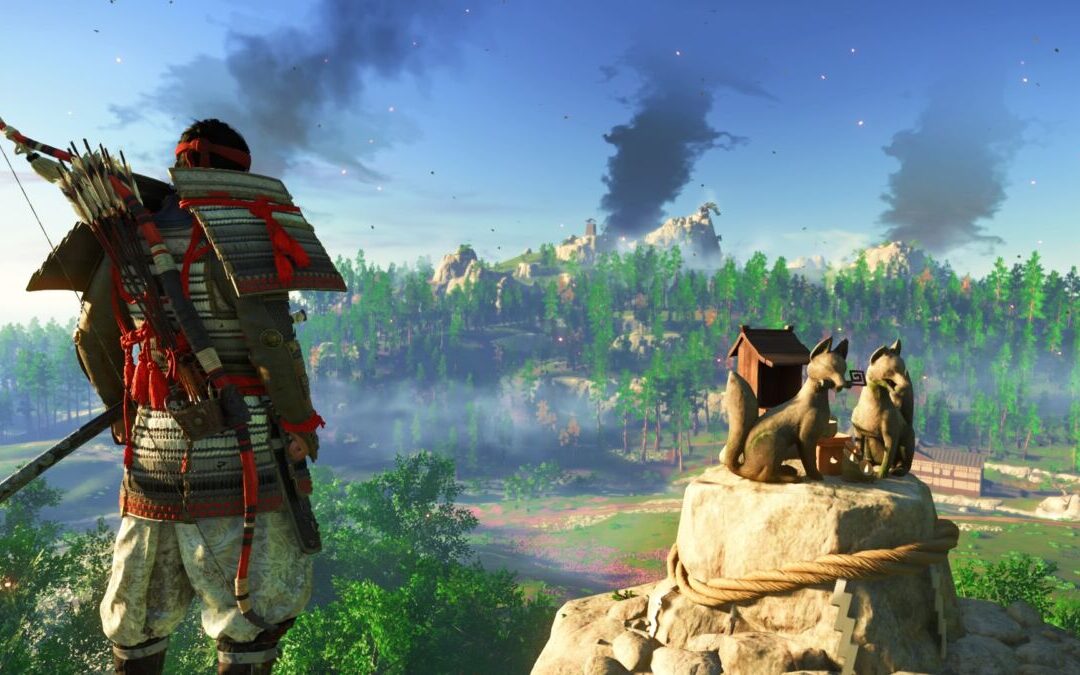I’ve played a lot of open world games this generation. The Witcher 3’s scale floored me back in 2015, Horizon’s beauty kept me exploring in 2017, and Marvel’s Spider-Man made me the happiest swinger (not like that) around in 2018. Since the latter’s release, though, I’ve not really gelled with an open world quite like Ghost of Tsushima’s.
From that gorgeous opening title card to the endless wonder of gazing out at the landscape before me, Ghost of Tsushima’s open world has utterly enthralled me. I’m only on Act II and have already sunk at least two dozen hours into ticking off every single thing I could within Izuhara, the game’s starting area. Never mind taking back Toyotama, I have foxes to pet.
As someone who regularly rolls their eyes at the kind of trope-y content developers stuff their open worlds with, I’ve been very surprised to see how absorbed I am by Tsushima’s. Yes, it’s still a checklist of samey stuff to do for full completion, but I think it’s in the way the game delivers these side-distractions that makes them so inviting.
The wind navigation is one of the game’s biggest selling points, so much so that I don’t think it will be long before other games try and copy it — anything in lieu of a compass or giant floating arrow. Orienteering by wind towards the next question mark on the map makes exploration feel organic, as if you are still fully discovering things for yourself despite the game regularly nudging you in the right direction. It all feels very organic.
It helps that everything you collect or discover is useful, unlike a lot of other open world games. Fox Dens leads you to charms that give buffs to stats and abilities, Onsens increase your maximum health, and those very addictive Bamboo Strikes, just to name a few. With all of these being fast travel spots and the game’s loading screens being famously swift, it’s just yet another reason to get on your horse and explore.
I also feel that a lot of the overlooked side-missions are worth playing. Even though they may lack the detail of the main missions, there’s some surprisingly great stories to be discovered on the island, whether that’s through characters hinting that there’s somewhere you should go based on a clue of theirs or you just naturally stumbling across something. Yuriko’s quests are absolutely worth playing, but I also saw a small island, swam there, and then found myself aboard a Mongol ship to save someone’ daughter.

Exploring and ticking things off your list is also worthwhile because of just how good it is at levelling you up; I am very much overlevelled for the rest of the story already and not even halfway through it. You can earn technique points over time, but there are also Mythic Tales that start with gorgeous animations and end in a tense duel. You receive the best gear in the game for completing these Mythic Tales, so they’re usually the first thing I do when a new one pops up.
All of this extra firepower just adds more weight to you feeling like a true samurai trying to reclaim their land. While Jin is by no means a slouch to start off with, once you start levelling him up with additional stances, powerful abilities, and better gear, Tsushima transforms into an endlessly cool power trip where you cut off heads without blinking.
I still have plenty of foxes to pet and more than a handful of haiku to jot down, but whereas other open world games might leave me feeling jaded by having so much to do, Ghost of Tsushima makes me want to never leave.
Ghost of Tsushima released on July 17th as the last big PS4 exclusive ahead of the launch of the PlayStation 5.
Some of the coverage you find on Cultured Vultures contains affiliate links, which provide us with small commissions based on purchases made from visiting our site. We cover gaming news, movie reviews, wrestling and much more.




